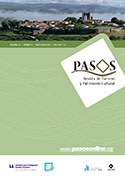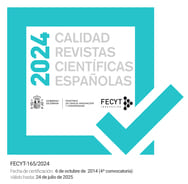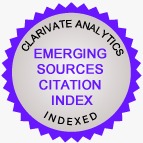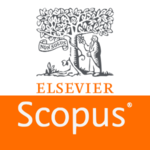Semiose turística das paisagens lacustres através da estética e das performatividades
DOI:
https://doi.org/10.25145/j.pasos.2025.23.023Palavras-chave:
Paisagens lacustres, semiótica peirceana, estética, performance, Laguna MerínResumo
Mobilizamos a semiótica para um exame mais aprofundado das representações visuais de paisagens lacustres e das performatividades corporais, empregando especificamente a distinção tipo/token, uma caraterística proeminente do modelo de signo de Charles Sanders Peirce (1839-1914). Assim, o objetivo principal foi abordar a seguinte questão a partir de um laboratório semiótico empírico no Sul, a Lagoa Merín (Brasil/Uruguai): Como é que os turistas encontram as paisagens lacustres e as percecionam em termos estéticos e performativos? Aplicámos uma abordagem metodológica qualitativa baseada em informação visual e textual, seguida de uma análise interpretativa informada pela distinção e complementaridade tipo/token. Os visitantes relacionam-se com as paisagens lacustres em termos visuais, corporais e performativos, enquanto materialidade destas paisagens de férias. O olhar coletivo complementa e confronta o olhar conservador destas paisagens, ainda centrado no Romantismo. Depois de avançarmos na compreensão atual destes fenómenos inter-relacionados, colocamos algumas questões para aprofundamento, acompanhadas de implicações práticas.
Downloads
##plugins.generic.pfl.publicationFactsTitle##
##plugins.generic.pfl.reviewerProfiles## Indisp.
##plugins.generic.pfl.authorStatements##
##plugins.generic.pfl.indexedIn##
-
##plugins.generic.pfl.indexedList##
- ##plugins.generic.pfl.academicSociety##
- PASOS. Revista de Turismo y Patrimonio Cultural
- ##plugins.generic.pfl.publisher##
- Instituto Universitario de Investigación Social y Turismo. Universidad de La Laguna (España) - Instituto Universitario da Maia ISMAI (Portugal)
Referências
Banks, M. (Trans.) (2009[2008]). Dados visuais para pesquisa qualitative [Qualitative data for qualitative research]. Porto Alegre: Bookman/Artmed.
Barthes, R. (Trans.) (1986). El obvio y lo obtuso: Imágenes, gestos, voces [The obvious and the obtuse: Images, gestures, voices]. Buenos Aires: Paidós.
Bell, C. & Lyall, J. (2008). The Accelerated Sublime: thrill-seeking adventure heroes in the commodified landscape. In Coleman, S. & Crang, M. (Eds.). Tourism: between place and performance (pp. 21- 34). New York/Oxford: Berghahn.
Boyer, M. (Trans.) (2003). História do turismo de massa [History of mass tourism]. Bauru: Edusc.
Brady, E. (2003). Aesthetics of natural environment. Edinburgh: Edinburgh University Press.
Brook, I. (2019). Aesthetic appreciation of landscape. In P. Howard, I. Thompson, E. Waterton, & Atha, M. (Eds.). The Routledge Companion to Landscape Studies (pp. 108-118). 2nd Ed. London/New York: Routledge.
Chandler, D. (2003). Semiotics: The basics. Routledge.
Conti, E., & Lexhagen, M. (2020). Instagramming nature-based tourism experiences: A netnographic study of online photography and value creation. Tourism Management Perspectives, 34, 100650https://doi.org/10.1016/j.tmp.2020.100650
Cooper, C. (2006). Lakes as tourism destination resources. In C. M. Hall & T. Härkönen (Eds.). Lake tourism: An integrated approach to lacustrine tourism systems (pp. 27-44). Cleveland/Buffalo/Toronto: Channel View Publications.
Crang, M. (2014). Cultural geographies of tourism. In A. Lew, C. Hall, & A. Williams (Eds.). The Wiley-Blackwell Companion to Tourism (pp. 66-77). Malden/Oxford/West Sussex: Wiley-Blackwell.
Crawshaw, C. & Urry, J. (1997). Tourism and the photographic eye. In Rojek, C. (Ed.). Touring cultures (pp. 186-205). London/New York: Routledge.
Cresswell, T. (2002). Landscape and the obliteration of practice. In Anderson, K., Domosh, M., Pile, S., & N. Thrift (Eds.). Handbook of Cultural Geography (pp. 269-281). London/Thousand Oaks/New Delhi: Sage Publications.
Cresswell, T. (2010). Towards a politics of mobility. Environment and Planning D: Society and Space, 28(1), 17–31. https://doi.org/10.1068/d11407
Crouch, D. (1999). Introduction. In Crouch, D. (Ed.). Leisure/tourism geographies: Practices and geographical knowledge (pp. 1-16). London: Routledge.
Crouch, D. (2004). Tourist practices and performances. In A. A. Lew, C. M. Hall, & A. M. Williams (Eds.). A Companion to Tourism (pp. 85-96). Malden/Oxford/Carlton: Blackwell Publishing.
Crouch, D. (2019). Landscape, performance and performativity. In P. Howard, I. Thompson, E. Waterton, & Atha, M. (Eds.). The Routledge Companion to Landscape Studies (pp. 119- 131). 2nd Ed. London/New York: Routledge.
Crouch, D., Aronsson, L., & Wahlström, L. (2001). Tourist encounters. Tourist Studies, 1(3), 253-270. https://doi.org/10.1177/146879760100100303
Culler, J. (1981). Semiotics of tourism. The American Journal of Semiotics, 1(1/2), 127-140.
Eco, U. (1976). Peirce’s notion of interpretant. MLN, 91(6), 1457–1472. https://doi.org/10.2307/2907146
Edensor, T. (2001). Performing tourism, staging tourism: (Re)producing tourist space and practice. Tourist Studies, 1(1), 59–81. https://doi.org/10.1177/146879760100100104
Edensor, T. (2007). Mundane mobilities, performances and spaces of tourism. Social & Cultural Geography, 8(2), 199–215. https://doi.org/10.1080/14649360701360089
Flick, U. (Trans.) (2009[1995]). Introdução à pesquisa qualitativa [Introduction to qualitative research]. 3rd Ed. Porto Alegre: Artmed/Bookman.
Franklin, A. & Crang, M. (2001). The trouble with tourism and travel theory? Tourist Studies, 1(1), 5-22. https://doi.org/10.1177/146879760100100101
Hall, C. M. (2015). On the mobility of tourism mobilities. Current Issues in Tourism, 18(1). Routledge. https://doi.org/10.1080/13683500.2014.971719
Hall, C. M. & Härkönen, T. (2006). Lake tourism: An introduction to Lacustrine Tourism. In C. M. Hall & T. Härkönen (Eds.). Lake tourism: An integrated approach to lacustrine tourism systems (pp. 3-26). Cleveland/Buffalo/Toronto: Channel View Publications.
Hall, C. M. & Valentin, A. (2005). Content analysis. In Ritchie, B. W., Burns, P., & Palmer, C. (Eds.). Tourism research methods: Integrating theory with practice (pp. 191-210). Oxfordshire: Cabi Publishing.
Hannam, K., Butler, G., & Paris, C. M. (2014). Developments and key issues in tourism mobilities. Annals of Tourism Research, 44(1), 171-185. https://doi.org/10.1016/j.annals.2013.09.010
Jennnings, G. R. (2005). Interviewing: A focus on qualitative techniques. In Rithcie, B. W., Burns, P., & Palmer, C. (Eds.). Tourism research methods: Integrating theory with practice (pp. 99-118). Oxfordshire: Cabi Publishing.
Jensen, O. B. (2013). Staging Mobilities. Routledge.
Jensen, O. B. (2014). Mobile semiotics. In Adey, P., Bissell, D., Hannam, K., Merriman, P. & Sheller, M. (Eds.). The Routledge Handbook of Mobilities (pp. 566-574). London/New York: Routledge.
Knudsen, D. C., Metro-Roland, M. M., & Rickly, J. M. (2015). Tourism, aesthetics, and touristic judgment. Tourism Review International, 19(4), 179–191. https://doi.org/10.3727/154427215X14456408880957
Knudsen, D. C., Rickly-Boyd, J. M., & Metro-Roland, M. M. (2012). Landscape perspective on tourism geographies. In J. Wilson (Ed.). Handbook of Tourism Geographies (pp. 201-207). London/New York: Routledge.).
Knudsen, D. C., Rickly, J. M., & Metro-Roland, M. M. (2017). Touring as a Perceian habit. Annals of Tourism Research, 57(1), 246–248. https://doi.org/10.1016/j.annals.2015.12.014
Knudsen, D. C., Soper, A. K., & Metro-Roland, M. (2007). Commentary: Gazing, performing and reading – a landscape approach to understand meaning in Tourism theory. Tourism Geographies, 9(3), 227–233. https://doi.org/10.1080/14616680701422681
Konu, H., Tuohino, A., & Komppula, R. (2010). Lake wellness – a practical example of a new service development (NSD) concept in tourism industries. Journal of Vacation Marketing, 16(2), 125–139. https://doi.org/10.1177/1356766709357489
Kunz, J. G. (2021). Paisagens e Turismo na-da Lagoa Mirim (Brasil/Uruguai): Complexus de práticas e significados. Ph.D. dissertation in Geography, The Federal University of Rio Grande do Sul, Brazil. Retrieved from https://lume.ufrgs.br/bitstream/handle/10183/221652/001126206.pdf?sequence=1&isAllowed=y
Larsen, J. (2006). Geographies of tourist photography: Choreographies and performances. In: Falkheimer, J. & Jansson, A. (Eds.). Geographies of Communication: The spatial turn in media studies (pp. 243-261). Gottemburg: Nordicom.
Larsen, J. & Urry, J. (2011). Gazing and performing. Environment and Planning D: Society and Space, 29(6), 1110-1125. https://doi.org/10.1068/d21410
Löfgren, O. (1999). On Holiday: the history of vacationing. Berkeley: University of California Press.
Lorimer, H. (2005). Cultural geography: the busyness of being ‘more-than-representational’. Progress in Human Geography, 29(1), 23–84. https://doi.org/10.1191/0309132505ph531pr
MacCannell, D. (1999[1976]). The tourist: a new theory of the leisure class. Berkeley: University of California Press.
Metro-Roland, M. M. (2009). Interpreting meaning: An application of Peircean Semiotics to Tourism. Tourism Geographies, 11(2), 270–279.
Metro-Roland, M. M. (2011). Tourists, signs, and the city: The Semiotics of Culture in an urban landscape. London/New York: Routledge.
Metro-Roland, M. M., & Kunz, J. G. (2019). An interview with Michelle Metro-Roland: Tourism, landscape, and the signs. Revista Rosa Dos Ventos – Turismo e Hospitalidade, 11(4), 973– 983. https://doi.org/10.18226/21789061.v11i4p973
Ness, S. A. (2016). Choreographies of landscape: Signs of performance in Yosemite National Park. London/Oxford: Berghahn.
Norum, R. & Mostafanezhad, M. A. (2016). A chronopolitics of tourism. Geoforum, 77(12), 157– 160. tps://doi.org/10.1016/j.geoforum.2016.10.015
Nöth, W. (1995). Handbook of Semiotics. Bloomington: Indiana University Press.
Peirce, C. S. (1955[1940]). Philosophical writings of Peirce. New York: Dover.
Potocka, I. (2013). The lakescape in the eyes of a tourist. Quaestiones Geographicae, 32(3), 85– 97.
Sang, S. (2021). Reconstructing the place branding model from the perspective of Peircean Semiotics. Annals of Tourism Research, 89(10329), https://doi.org/10.1016/j.annals.2021.103209
Santaella, L. (2017). Charles Sanders Peirce (1839-1914). In Aguiar, L. & Barsotti, A. (Eds.). Clássicos da Comunicação: Os teóricos de Peirce a Canclini [Communication classics: thinkers from Peirce to Canclini] (pp. 20-35). Petrópolis: Vozes.
Scarles, C. (2004). Mediating landscapes: The processes and practices of image construction in tourist brochures of Scotland. Tourist Studies, 4(1), 43–67. https://doi.org/10.1177/1468797604053078
Seamon, D. (2000). A way of seeing people and place: phenomenology in environment-behavior research. In Wapner, S., Demick, J., Yamamoto, T., & Minami, H. (Eds.). Theoretical perspectives in Environment-behavior research: Underlying assumptions, research problems, and methodologies (pp. 157-178). Springer: New York.
Stanford Encyclopedia of Philosophy (2006). Types and tokens. Retrieved from https://plato.stanford.edu/entries/types-tokens/
Tressider, R. (2011). The semiotics of tourism. In P. Robinson, S. Heitmann, & P. Diecke (Eds.). Research Themes for Tourism (pp. 59-68). Oxfordshire: Cabi Publishing.
Trip Advisor (2020). Aonde você quer ir? Retrieved from https://www.tripadvisor.com.br
Urry, J. (1990). The tourist gaze: Leisure and travel in contemporary societies. London/Thousand Oaks/New Delhi: Sage Publications.
Veal, A. J. (2006). Research methods for leisure and tourism. 5th Ed. London: Pearson.
Vaose, R. (2021). Tourist experience: A semiotic perspective. In Sharpley, R. (Ed.). The Routledge Handbook of Tourist Experience (pp. 128-139). London/New York: Routledge.
Wylie, J. (2007). Landscape. London/New York: Routledge.
Yin, R. K. (2014). Case study research. London/Thousand Oaks/New Delhi: Sage Publications.
Wylie (2017). The distant: Thinking toward renewed senses of landscape and distance. Environment, Space, Place, 9(1), 1-20.
Yin, R. K. (2010). Qualitative research from start to finish. New York: The Guilford Press.
Downloads
Publicado
Como Citar
Edição
Seção
Licença
Copyright (c) 2025 Jaciel Gustavo Kunz, Antonio Carlos Castrogiovanni, Michelle M. Metro-Roland

Este trabalho está licenciado sob uma licença Creative Commons Attribution-NonCommercial-NoDerivatives 4.0 International License.
Confirmo que o trabalho é original (de minha/nossa autoria), e que não será submetido a outras revistas ou publicações até a resolução final do processo de revisão em PASOS, RTPC.
Autorizo a publicação do meu trabalho por PASOS, PSTN de acesso livre e aberto em qualquer dos formatos que considere oportuno, por tempo indeterminado e como colaboração não remunerada.
Da mesma forma, o(s) autor(es) entende(m) que o trabalho publicado pode ser vinculado ou depositado em qualquer servidor ou incluído em outras publicações (republicação), desde que o novo local e/ou a nova edição façam referência à publicação original e reconheçam a autoria e propriedade de direitos autorais das publicações PASOS RTPC.
Os autores entendem que uma verificação de plágio autoplágio será realizada, e o artigo poderá ser removido a qualquer momento do fluxo editorial.










